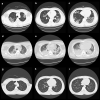Comparison of patients hospitalized with COVID-19, H7N9 and H1N1
- PMID: 33261654
- PMCID: PMC7707904
- DOI: 10.1186/s40249-020-00781-5
Comparison of patients hospitalized with COVID-19, H7N9 and H1N1
Abstract
Background: There is an urgent need to better understand the novel coronavirus, severe acute respiratory syndrome coronavirus 2 (SARS-CoV-2), for that the coronavirus disease 2019 (COVID-19) continues to cause considerable morbidity and mortality worldwide. This paper was to differentiate COVID-19 from other respiratory infectious diseases such as avian-origin influenza A (H7N9) and influenza A (H1N1) virus infections.
Methods: We included patients who had been hospitalized with laboratory-confirmed infection by SARS-CoV-2 (n = 83), H7N9 (n = 36), H1N1 (n = 44) viruses. Clinical presentation, chest CT features, and progression of patients were compared. We used the Logistic regression model to explore the possible risk factors.
Results: Both COVID-19 and H7N9 patients had a longer duration of hospitalization than H1N1 patients (P < 0.01), a higher complication rate, and more severe cases than H1N1 patients. H7N9 patients had higher hospitalization-fatality ratio than COVID-19 patients (P = 0.01). H7N9 patients had similar patterns of lymphopenia, neutrophilia, elevated alanine aminotransferase, C-reactive protein, lactate dehydrogenase, and those seen in H1N1 patients, which were all significantly different from patients with COVID-19 (P < 0.01). Either H7N9 or H1N1 patients had more obvious symptoms, like fever, fatigue, yellow sputum, and myalgia than COVID-19 patients (P < 0.01). The mean duration of viral shedding was 9.5 days for SARS-CoV-2 vs 9.9 days for H7N9 (P = 0.78). For severe cases, the meantime from illness onset to severity was 8.0 days for COVID-19 vs 5.2 days for H7N9 (P < 0.01), the comorbidity of chronic heart disease was more common in the COVID-19 patients than H7N9 (P = 0.02). Multivariate analysis showed that chronic heart disease was a possible risk factor (OR > 1) for COVID-19, compared with H1N1 and H7N9.
Conclusions: The proportion of severe cases were higher for H7N9 and SARS-CoV-2 infections, compared with H1N1. The meantime from illness onset to severity was shorter for H7N9. Chronic heart disease was a possible risk factor for COVID-19.The comparison may provide the rationale for strategies of isolation and treatment of infected patients in the future.
Keywords: COVID-19; Comparison; H1N1; H7N9; SARS-CoV-2.
Conflict of interest statement
The authors declare no conflict of interest.
Figures



References
Publication types
MeSH terms
LinkOut - more resources
Full Text Sources
Medical
Research Materials
Miscellaneous

